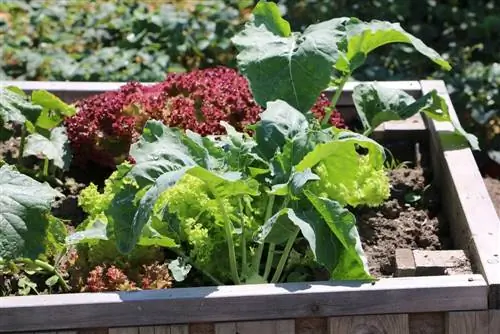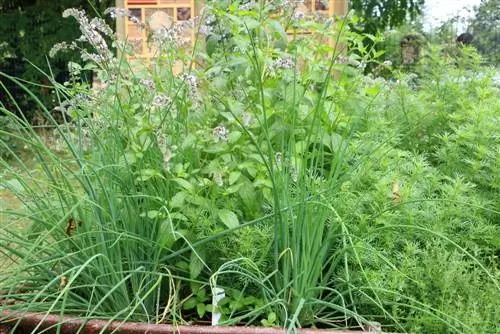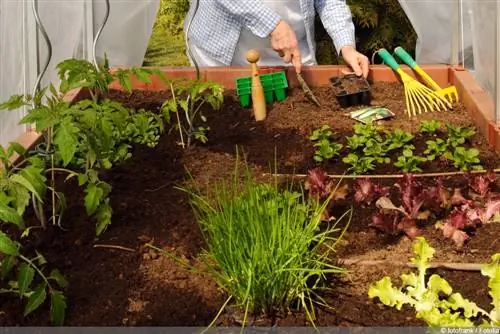- Author admin [email protected].
- Public 2023-12-17 03:39.
- Last modified 2025-06-01 06:48.
The bed border is a rarity in natural kitchen gardens. Spacious vegetable plants grow happily into the neighboring bed, where the long tendrils of pumpkin, beans and cucumbers have long since established themselves. There is no trace of a well-groomed appearance, let alone structured plant care. A wooden bed border solves the problem in harmony with your ecological garden culture. These 5 ideas want to inspire your imagination.
Wooden palisade - flexible and uncomplicated
An elegant solution for bordering the vegetable bed is the wooden palisade. The rolling element consists of halved wooden pegs stapled together. Due to its flexibility, the palisade is suitable as a border for any bed shape. The seamless arrangement of the wood ensures that an adjacent lawn no longer grows into the bed and is difficult to mark out. When purchasing, it is preferable to use rollboaders as a plug-in fence because they already have extended posts for attachment to the ground. To set up a rolled wooden palisade without built-in posts, dig a furrow with a small bed of gravel along the vegetable bed. Use a rubber mallet to drive the wooden palisade a little way into the gravel and close the furrow with soil.
Build your own bed border from squared timber
- clever use of excess timber -
Home gardeners with skilled craftsmanship ignore prefabricated elements and simply construct a wooden bed border themselves. The aim is to create a cost-effective and stable frame for the vegetable patch, with an individual design that catches the eye. This idea is based on square timbers that can be found as offcuts in wood shops and hardware stores at a bargain price. Square softwood beams are ideal if you smooth them out in advance with sandpaper and impregnate them with a transparent glaze to protect them from the effects of the weather. How to proceed correctly step by step:
- Cut wood to the same or different lengths with a jigsaw or circular saw
- Dig a spade-deep trench along the vegetable bed, matching the width of the wood
- Cover the bottom of the pit with a 10 centimeter thick layer of gravel
- Use a rubber mallet to hammer the pieces of wood side by side into the gravel bed
- Fill the bed border with soil from both sides and tamp it down
You can give additional stability to a border that is more than 20 centimeters high with quick-release concrete. Instead of using soil, fill the furrow with a ready-made mix from the hardware store that only needs to be mixed with water.
Tip:
The wood from local trees is well prepared for the Central European climate and is cheaper than tropical wood. Larch wood, one of the hardest softwoods, is recommended. Douglas fir and pine wood are also suitable for bordering the bed. It is cheaper to use pressure-impregnated spruce wood.
Wave fence - rustic and authentic

Wooden woven elements impress as a bed border with rustic charm. Wicker fences made of willow or hazelnut, which decoratively frame the vegetable patch, are very popular. Specialist retailers have ready-made elements as a fence with a length of 120 centimeters and a height of 20 centimeters for less than 5 euros. Ecologically oriented home gardeners appreciate that it is a local and renewable raw material. Special advantage: A willow or hazelnut wicker fence as a bed border does not require any impregnation measures.
Bamboo sticks - close to nature and affordable
Bamboo sticks are familiar to many home gardeners as a building material for natural trellises. A new insight may be its use as a bed border. In particular, thick bamboo tubes with a diameter of 15 millimeters or more decoratively frame a vegetable bed. With a length of 100 centimeters, the sticks are available for a unit price of 25 to 35 cents. Cut the bamboo sticks to the appropriate size to stick them side by side in the soil along the vegetable bed. The specialist retailer offers bamboo as a bed border, ready-made as a roll or plug-in fence, starting at a price of 15 euros for an element with a length of 120 centimeters and a height of 30 centimeters.
Benje hedge in mini format
- Bed border and ecosystem at the same time -
The following idea is aimed at home gardeners who prefer to set up new ecosystems in their green kingdom. If you choose a small Benje hedge as a border for the vegetable patch, you will remain true to your gardening philosophy. At the end of the 1980s, when a landscape gardener thought about the sensible use of clippings, the idea of the deadwood hedge was born, named after its inventor, Hermann Benjes. Since the principle can be implemented on any conceivable scale, a mini Benje hedge is perfect as a border in the vegetable garden. It's that easy:
- Mark the line of the bed border with the spade
- Sharpen the thicker branches of the last tree cut with an ax to make small support posts
- Tuck support branches into the ground at a distance of 20 to 50 centimeters at the edge of the bed
- Put in a second row of branches opposite to match the desired border width
Stack the cuttings between the two rows of support posts. Ideally, you start with thick branches and fill the pile with thin twigs and leaves.
Positive side effect:
Over time, numerous beneficial insects settle in the small Benje hedge and actively participate in plant protection in the vegetable patch.






